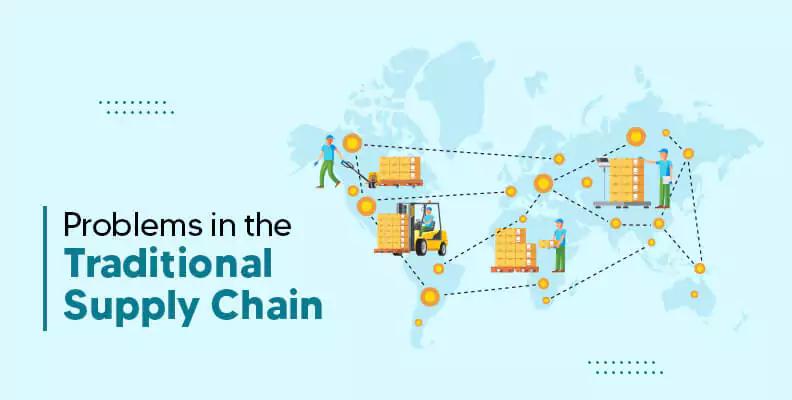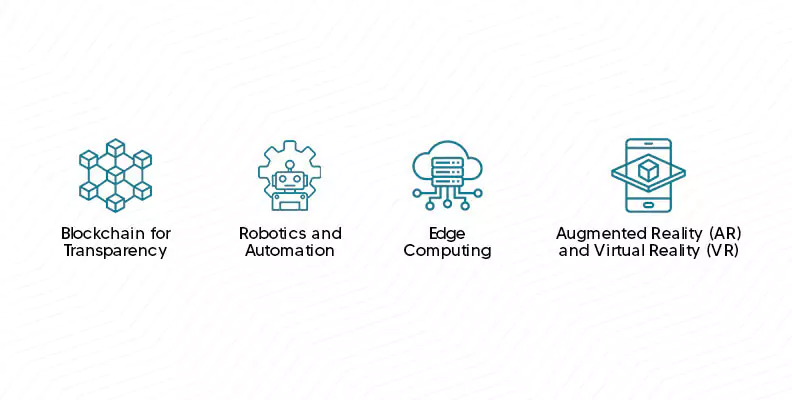Loading.....
Reshaping the Global Supply Chain Landscape with Technology

In the intricate realm of global commerce, the supply chain assumes a pivotal role by seamlessly connecting manufacturers, distributors, and retailers. However, this intricate web is not impervious to challenges. The complexity and rigidity within this sector have undergone a significant transformation, thanks to technological advancements. In this blog let's explore the prevailing problems in the current supply chain, shedding light on issues that businesses must address to ensure a more seamless and efficient flow of goods. It also explores how technology has reshaped and optimized supply chain and logistics processes, contributing to heightened efficiency, transparency, and overall performance.
Problems in the Traditional Supply Chain

- Fragmented Communication: A significant obstacle in the modern supply chain is fragmented communication. As supply chains span across geographical boundaries and involve numerous stakeholders, effective communication becomes paramount. Unfortunately, many organizations still grapple with siloed information and poor communication channels, leading to delays, misunderstandings, and inefficiencies.
- Inventory Management Woes: Inefficiencies in inventory management contribute to increased costs and decreased profitability. Overstocking or understocking can disrupt the delicate balance of the supply chain, resulting in lost sales opportunities or excess carrying costs.
- Supply Chain Disruptions: The past few years have witnessed an unprecedented number of disruptions, from natural disasters to global pandemics. These disruptions highlight the vulnerability of the current supply chain to unforeseen events. Overreliance on single suppliers or centralized manufacturing hubs amplifies the impact of these disruptions.
- Lack of Sustainability: As environmental concerns take centre stage, supply chains are scrutinised for their ecological footprint. Many supply chains still lack sustainability practices, contributing to environmental degradation and societal concerns.
- Technological Lag: Some supply chains lag in adopting cutting-edge technologies. Manual processes and outdated systems hinder efficiency, making keeping pace with the rapidly evolving business landscape challenging.
Technology Solutions for Traditional Supply Chain Problems
From communication bottlenecks to sustainability concerns, businesses are grappling with issues that demand innovative solutions. Thankfully, technology emerges as a powerful ally in the quest for a more efficient and resilient supply chain. Here is how cutting-edge technologies can be harnessed to address the problems plaguing the supply chain.
-
Enhanced Communication through Digital Platforms: Technology offers a lifeline to combat fragmented
communication. Digital
platforms and collaborative tools can break
down silos, facilitating seamless information sharing among stakeholders. Cloud-based solutions enable
real-time
updates, reducing delays and fostering a more connected and informed supply chain network.
A prime example is how multinational corporations like Procter & Gamble have embraced cloud-based collaboration tools. By implementing systems that allow real-time communication and data sharing, P&G has streamlined its global supply chain, reducing delays and enhancing overall efficiency.

-
Optimized Inventory Management with Data Analytics: Advanced technologies like data analytics play
a pivotal role in optimizing inventory management. By analyzing
historical data, current trends, and market demand, businesses can make data-driven decisions to prevent
overstocking or
understocking. Predictive analytics empowers organizations to forecast demand accurately, ensuring a lean
and efficient
inventory.
Amazon, an e-commerce giant, utilizes sophisticated algorithms and data analytics to forecast demand accurately. By analyzing customer behaviour, market trends, and historical data, Amazon minimizes overstocking and understocking issues, ensuring a lean and responsive inventory.

-
Resilience through Digital Twins and Simulation: To tackle supply chain disruptions, technology
introduces the concept of digital twins and simulation models. Digital
twins create virtual replicas of the supply chain, allowing businesses to simulate and analyze various
scenarios. This
enables proactive risk management, helping organizations develop robust contingency plans to navigate
unforeseen events.
Walmart is a notable example of a brand employing technology for resilience. Walmart uses digital twins to create virtual replicas of its supply chain. By simulating various scenarios, Walmart can proactively identify and address potential disruptions, ensuring a more resilient and agile supply chain.

-
Greening the Supply Chain with Sustainable Technologies: Technology can be a driving force in
achieving sustainability goals. From blockchain for transparent supply chain
traceability to AI for energy-efficient operations, embracing sustainable technologies minimizes
environmental impact.
Innovations in packaging materials and recycling technologies contribute to creating a more eco-friendly
supply chain.
Unilever, a consumer goods giant, has committed to sustainability by leveraging blockchain technology for supply chain transparency. Unilever's blockchain system allows consumers to trace the journey of products, ensuring ethical sourcing and environmentally friendly practices.

-
Embracing Industry 4.0 for Future-Proofing: Industry 4.0 technologies, including the Internet of
Things (IoT) and artificial intelligence, pave the way for a
future-proof supply chain. IoT sensors provide real-time visibility into logistics, while AI enhances
decision-making
processes. These technologies empower businesses to stay agile and responsive in an ever-evolving market.
Siemens is a prime example of a company at the forefront of Industry 4.0 adoption. Siemens employs IoT sensors to monitor its manufacturing processes in real-time, optimizing efficiency and responsiveness.

New and Emerging Trends 2024

- Blockchain for Transparency: Blockchain technology ensures transparency by creating an immutable and traceable record of transactions throughout the supply chain, reducing fraud and enhancing accountability.
- Robotics and Automation: Edge computing brings computing power closer to the data source, enabling real-time data processing. In the supply chain, this can enhance responsiveness and decision-making, especially in remote or distributed
- Edge Computing: Blockchain technology ensures transparency by creating an immutable and traceable record of transactions throughout the supply chain, reducing fraud and enhancing accountability.
- Augmented Reality (AR) and Virtual Reality (VR): AR and VR technologies are revolutionizing training, maintenance, and assembly processes in the supply chain, leading to increased accuracy and reduced downtime.
Steps to Digitize Your Supply Chain
The seamless integration of digital technologies can enhance visibility, streamline operations, and optimize overall performance. Let’s explore the top seven steps to digitizing your supply chain and unlocking a new realm of possibilities for your business:
- Assess Current Processes: Before embarking on the digital transformation journey, it's crucial to conduct a comprehensive assessment of your current supply chain processes. Identify bottlenecks, inefficiencies, and areas that can benefit from automation. Understanding your existing workflow will provide valuable insights into which digital solutions will best suit your business needs.
- Invest in a Cloud-Based Infrastructure: Transitioning to a cloud-based infrastructure is a pivotal step in digitizing your supply chain. Cloud technology offers scalability, real-time data accessibility, and collaboration features, enabling seamless communication across various stakeholders. This digital foundation provides the flexibility needed to adapt to evolving market demands and ensures a more agile supply chain
- Implement an Integrated Supply Chain Management (SCM) System: Invest in a robust SCM system that integrates all aspects of your supply chain, from procurement to distribution. This centralized platform enhances visibility by providing real-time data on inventory levels, order statuses, and production schedules. Integration reduces manual errors and enhances decision-making processes, allowing for a more responsive and efficient supply chain.
- Embrace Internet of Things (IoT) Technology: IoT devices play a crucial role in creating a connected and intelligent supply chain. By incorporating sensors and smart devices, businesses can gather real-time data on the condition, location, and status of goods in transit. This data-driven approach improves traceability, minimizes risks, and allows for proactive decision-making, ultimately enhancing the overall efficiency of the supply chain.
- Utilize Artificial Intelligence (AI) and Machine Learning (ML): AI and ML technologies empower businesses to analyze vast amounts of data to derive actionable insights. Implementing predictive analytics can help forecast demand, optimize inventory levels, and identify potential disruptions before they occur. AI-driven automation can streamline routine tasks, reducing operational costs and allowing personnel to focus on more strategic aspects of supply chain management.
- Enable Electronic Data Interchange (EDI): Replacing paper-based processes with Electronic Data Interchange (EDI) promotes faster and more accurate exchange of information between trading partners. EDI enhances communication, reduces errors associated with manual data entry, and accelerates order processing. This digitized communication protocol ensures a more efficient and reliable flow of information throughout the supply chain network.
- Prioritize Cybersecurity Measures: As you digitize your supply chain, it's crucial to prioritize cybersecurity measures to safeguard sensitive data. Implement robust encryption, authentication, and access control mechanisms to protect against potential cyber threats. Regularly update your security protocols to stay ahead of evolving cyber risks and ensure the integrity of your digital supply chain infrastructure.
Want to streamline operations and enhance supply chain efficiency with cutting-edge technologies?
Conclusion
In conclusion, the evolving landscape of the global supply chain is undergoing a profound transformation propelled by technological advancements. This blog has highlighted the pressing challenges faced by traditional supply chains, from fragmented communication to sustainability concerns, and delved into how technology serves as a catalyst for positive change. As we peer into the trends of 2024, the integration of blockchain for transparency, robotics and automation, edge computing, and augmented reality underscores the continuous innovation shaping the industry. The provided steps to digitize the supply chain serve as a roadmap for businesses aiming to unlock efficiency and visibility. The future is undoubtedly digital, and by adopting these transformative technologies, companies can not only navigate current challenges but also position themselves at the forefront of a more resilient, sustainable, and efficient supply chain ecosystem.
 Back to blog
Back to blog












